Want to sell more on Instagram? Could working with micro-influencers help you reach more of the right people?
In this article, you’ll learn how to find and work with niche Instagram influencers and discover why they can become the ideal ambassadors for your brand.

Why You Should Partner With Micro-Influencers on Instagram
If your brand is new to Instagram influencer marketing, it’s easy to assume that all brand ambassadors are more or less equal—or that those with larger audiences are automatically better. In reality, micro-influencers are in a category of their own and there are plenty of reasons to seek them out.
Compared to celebrity social media influencers with a follower count of a million or more, micro-influencers typically have much smaller audiences of 10,000 to 100,000 followers. But in this case, a smaller audience doesn’t necessarily mean fewer results.
Micro-influencers’ followers tend to be highly engaged. Rather than passively consuming social media content in the Instagram feed, their followers tend to like, comment on, and share micro-influencers’ Instagram posts. In some cases, that engagement from Instagram users translates to following the brands that micro-influencers mention and buying the products they recommend.
That’s because micro-influencers tend to be both passionate and knowledgeable about niche topics. Followers typically turn to them for their expertise and trust the advice they share. And since micro-influencers have more manageable audience sizes than the average top Instagram influencers, they often interact directly with engaged followers.
So should you consider a micro-influencer over a brand ambassador with a substantially larger following? Let’s look at a few of the most compelling reasons.
Higher Engagement
As a general rule, influencer engagement rates decrease as audience sizes increase. But that doesn’t mean choosing influencers with the highest engagement rates (and therefore smallest audiences) is the best option.
Micro-influencers offer a good balance between engagement rate and audience size. That means you can feel confident that your target audience will respond to influencer content without worrying that the total audience size will be too small to reach your goals.
Authentic Content
Although many niche influencers are professional content creators, their social media posts rarely appear overly produced. Instead, they create relatable lifestyle content, which helps them make genuine connections with their followers.
While micro-influencer content may not look as sleek as your branded content, that’s a good thing. Many people have trouble trusting brands, and Millennials dislike ads. That means content that appears authentic may be more likely to appeal to your audience, depending on your target demographics.
Affordable Rates
From campaign complexity to marketing channels, several factors affect how influencers price their services. In most cases, audience size and potential reach are major factors in determining the cost of an influencer marketing campaign.
That means micro-influencers tend to have much more affordable rates than the average celebrity influencer. If you’re looking to get started with influencer marketing on a limited budget, partnering with micro-influencers can be a smart choice.
#1: How to Find Instagram Influencers
Now you know how helpful micro-influencers can be for marketing your brand. So how do you go about finding the right brand partner?
Get World-Class Marketing Training — All Year Long!
Are you facing doubt, uncertainty, or overwhelm? The Social Media Marketing Society can help.
Each month, you’ll receive training from trusted marketing experts, covering everything from AI to organic social marketing. When you join, you’ll also get immediate access to:
- A library of 100+ marketing trainings
- A community of like-minded marketers
- Monthly online community meetups
- Relevant news and trends updates
You can certainly invest in one of the many influencer marketing platforms. Most are all-in-one tools that do everything from identifying Instagram influencers and facilitating pitches to processing payments and providing analytics.
But you can also handle these tasks with native tools from Meta. Let’s look at how to get started with the Instagram app and Meta Business Manager.
Search for Micro-Influencers on Instagram
First, search for relevant keywords in the Instagram app. For example, if you’re marketing a cosmetics brand, you might start with a search for “beauty influencer.” Take a look at the top accounts that pop up in your search and tap through to learn more about each.

You’ll want to look at a few factors, starting with their account size. If you’re looking for micro-influencers, you’ll probably want to eliminate influencers with more than 100,000 followers.
Then take a look at each account’s bio. Confirm that their location is in your service area and make sure their focus area fits your brand. Then scroll through some of their recent content. You won’t be able to see all of their engagement metrics but you can use public interactions to gauge whether they would make a good brand partner.
For example, it’s helpful to check the quality of the comments. Do they sound like they come from real people with genuine responses or questions? Or do they sound like they came from automated accounts? Does the influencer respond to the genuine engagement or do they leave commenters hanging?
Browse Instagram Influencer Hashtags
After scrolling through the top accounts for your keyword, check the hashtag search results. On the Tags tab, you’ll find related hashtags that can help you fine-tune your search. For example, you might find that “beauty bloggers” and “beauty hacks” have a lot of relevant content.

You’ll find a lot of top-performing content under the most popular hashtags. But don’t ignore hashtags with fewer than 500,000 posts. You’re likely to find some micro-influencers under these more niche hashtags. Tap any promising hashtags to see top content related to the topic and research each of the Instagram influencers using the same workflow as above.
If you find any promising candidates, use their Instagram profiles to find even more micro-influencers. Tap the plus button below their bio to see similar accounts and then tap to take a look at the suggestions.

Check Your Instagram Followers
It’s easy to assume that you need to look outside of your existing audience to find micro-influencers. But if your brand regularly publishes great content on Instagram, there’s a chance that Instagram influencers are already following you.
To find them, take a look at the accounts that frequently comment on your content or send you DMs. Tap to check their profiles and see if they have influencer potential. If so, you’ve already got a head start on the next step.
Get to Know Potential Brand Partners
As you identify potential brand partners, work on getting to know them. When you follow their accounts, tap to add them to your Favorites list. That way, you’ll have a better chance of seeing their content in your feed. As you populate your list, you can also tap to select your Favorites feed and view influencer content exclusively.

Before pitching a partnership, it’s helpful to form a relationship with potential candidates. You can do that by leaving genuine, non-salesy comments on their content. When it’s time to pitch a campaign, your message won’t come as a surprise, which can help increase the chance of receiving a positive response.
#2: How to Plan Campaigns With Instagram Influencers
Now you have a list of potential candidates and you’ve started to create relationships with micro-influencers in your industry. So how do you turn your research into partnerships? Follow the steps below to map out micro-influencer campaigns.
Set Campaign Goals
Like all social media marketing campaigns, micro-influencer partnerships should have specific goals. Defined objectives give you a better understanding of the value you can get from a campaign and help you anticipate how micro-influencers would contribute to larger marketing goals.
Common goals for micro-influencer partnerships include:

Discover Proven Marketing Strategies and Tips
Want to go even deeper with your marketing? Check out the Social Media Marketing Podcast! Publishing weekly since 2012, the Social Media Marketing Podcast helps you navigate the constantly changing marketing jungle, with expert interviews from marketing pros.
But don’t let the name fool you. This show is about a lot more than just social media marketing. With over 600 episodes and millions of downloads each year, this show has been a trusted source for marketers for well over a decade.
- Expanding your customer base: By introducing your brand to their audience, micro-influencers can increase awareness of your products and services and help you gain more Instagram followers.
- Getting more subscribers: Instagram audience growth is great, but micro-influencers can also help you attract more email subscribers, which can be ideal for getting prospects in your funnel.
- Increasing sales and revenue: Micro-influencers can also help you reach lower-funnel goals like sales. Promo codes and custom URLs are great for attributing sales to specific brand partners.
At first, you may not know how many results you can expect from a partnership. It’s always a good idea to ask potential brand partners what kind of results their previous campaigns have achieved. As you gather data from your own campaigns, you can start to set realistic benchmarks.
Decide on a Budget
Next, decide how much you want to spend on Instagram influencer marketing. Because rates are likely to fluctuate from influencer to influencer, it’s helpful to think about your total spend. That way, you can allocate extra as necessary for more expensive influencers.
Not sure how much to budget? Consider your goals and think about what they’re worth to your organization. For example, you might calculate how much a new follower or new customer acquisition is worth. Then you can work backward to estimate your total budget.
Not sure if your budget is realistic? Take a flexible approach. You can always ask influencers for their rates and adjust your budget and expectations accordingly.
Create Campaign Briefs
As experienced creators, micro-influencers often have lots of great ideas for marketing campaigns. You can certainly rely on them to guide the creative aspects of your campaigns. But it’s a good idea to tell them what you’d like the campaign to accomplish.
A typical micro-influencer campaign brief discusses:
- The brand, including an introduction with basic talking points
- The product or service to highlight, including features and specs
- The offer, including website links and discount codes
- The scope, including the social media channels and number of Instagram posts
- The timeframe, including potential dates for the content to go live
Most influencer campaign briefs also include suggestions for types of content such as:
- Product reviews
- Styling suggestions
- Original recipes
- Lifestyle content
- Tutorials
- Giveaways
Pitch Micro-Influencers
Once you’ve worked out all of the details of your campaign, you’re ready to pitch the micro-influencers on your list. Be sure to check the influencer’s Instagram bio, as many specify their preferred contact method for pitches. If they prefer email, you can click the Email button in their bio to contact them directly.
In other cases, you can pitch them via Instagram Direct. Then head over to Business Suite to manage the conversation. In Business Suite, you can add labels so you can easily find active conversations with micro-influencers.
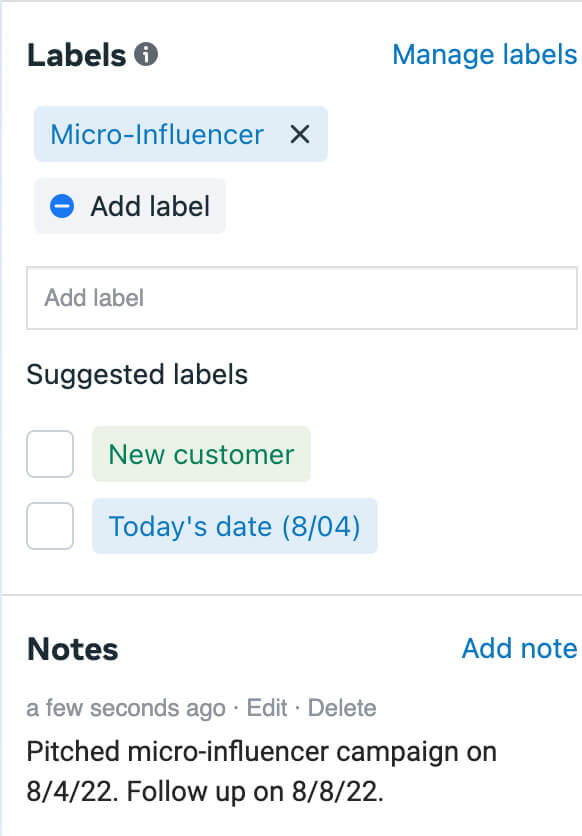
You can also flag messages for follow-up to avoid losing them in the shuffle. And you can write notes to ensure your team is in the loop.
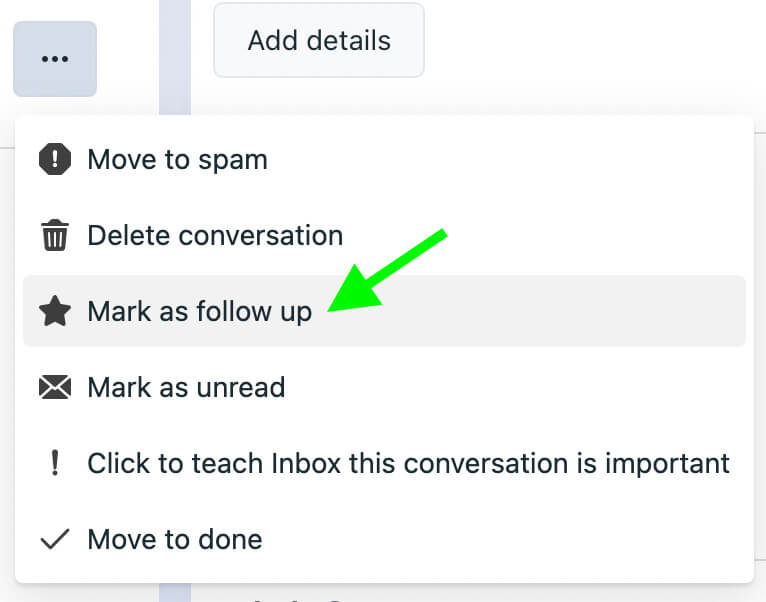
Pre-Approve Brand Partners
When micro-influencers promote your brand on Instagram, the platform requires them to tag it as branded content. When they use Instagram’s branded content tool, a Paid Partnership tag automatically appears under their username, identifying your brand as the sponsor.
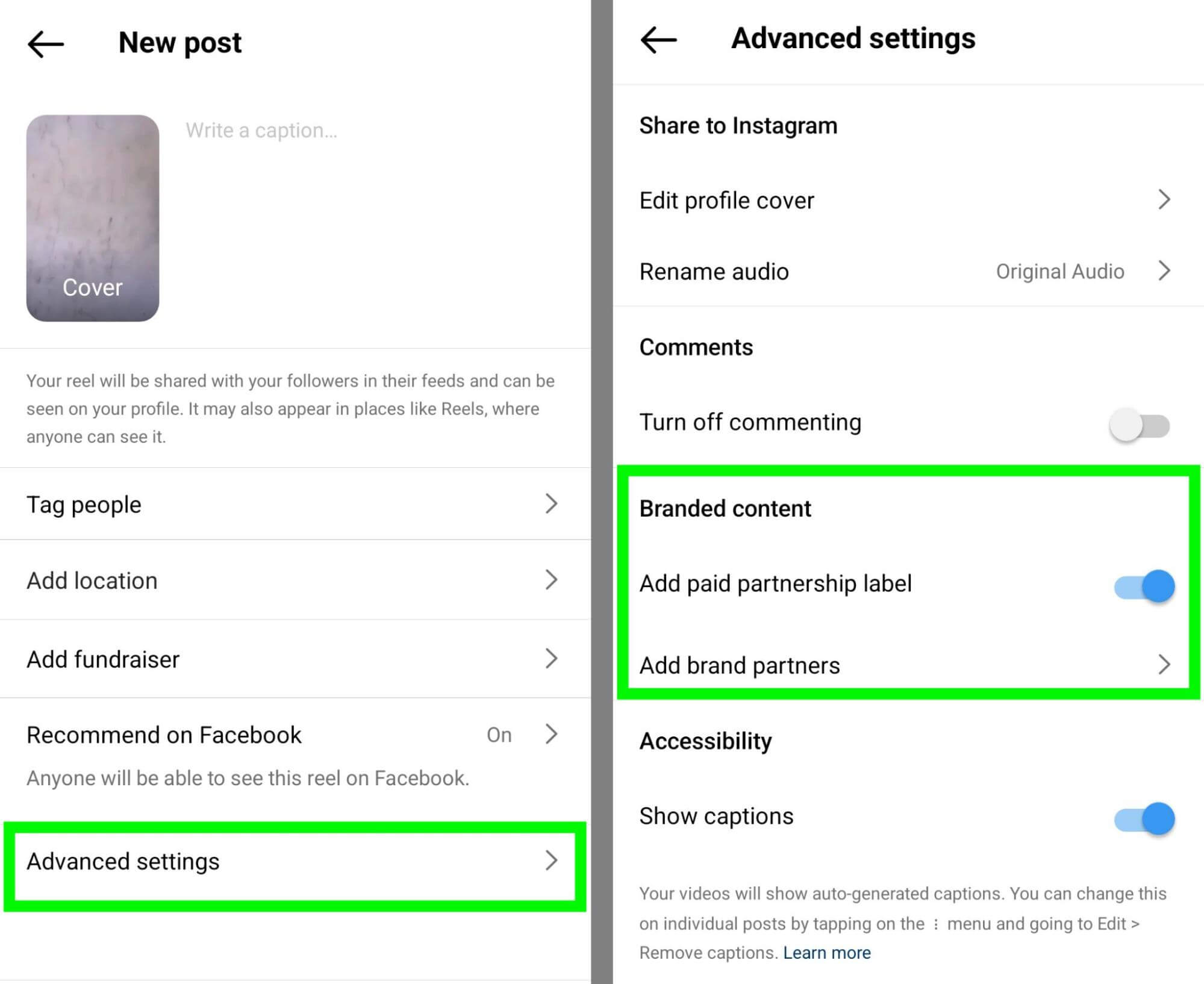
In some cases—especially with sponsored Instagram Lives—the platform requires brands to pre-approve influencers for branded content. No matter what type of content you’re planning, it’s always a good idea to pre-approve any influencers you plan to partner with. Then they can easily find your account and avoid publishing delays.
To pre-approve brand partners, open the settings for your Instagram account. Tap Business and go to Branded Content. Then tap Approve Content Creators and search for the micro-influencers you want to add. When they add the Paid Partnership label to their content, they’ll see your account in their list of approved brand partners.
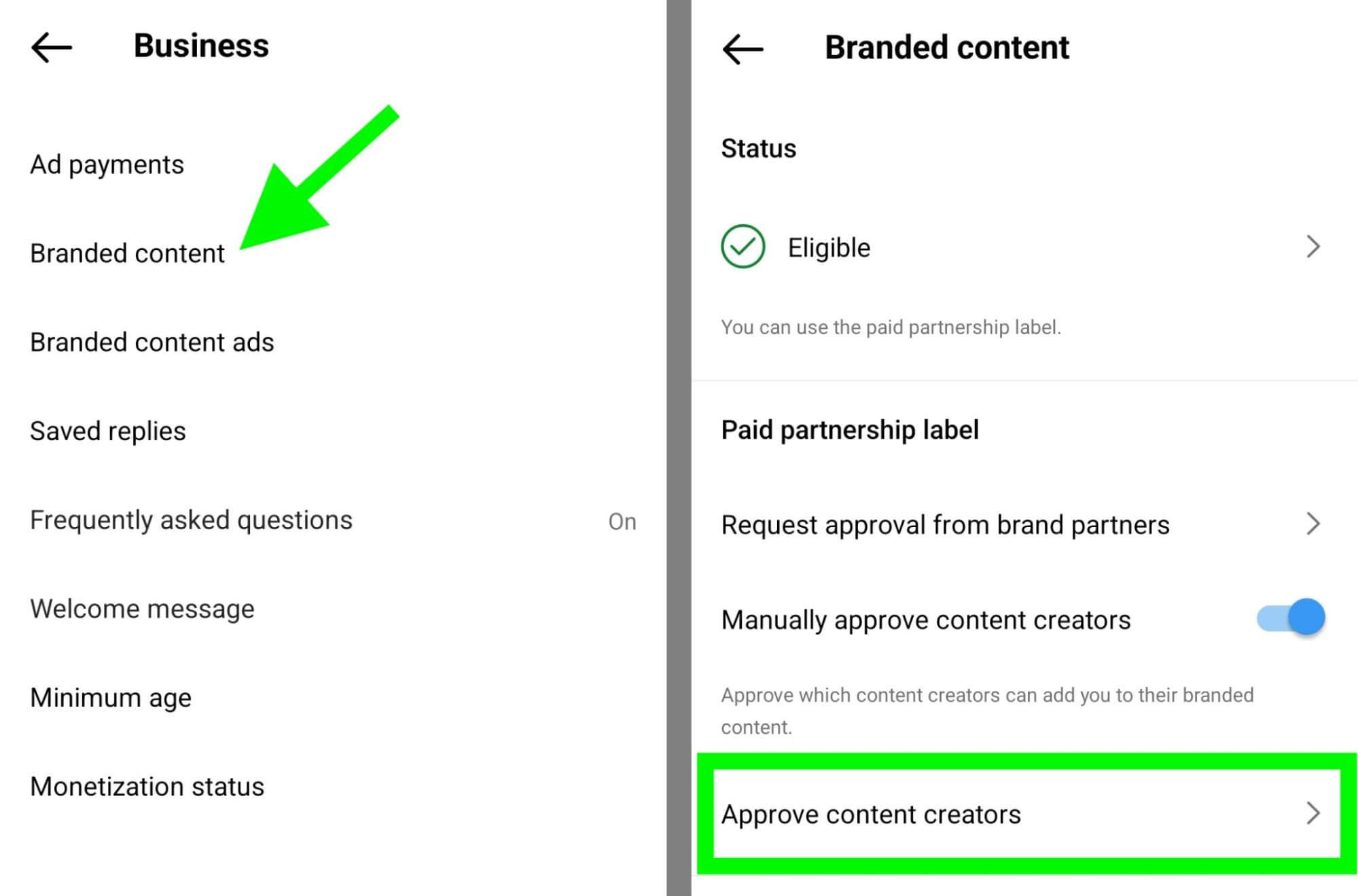
#3: Where to Monitor Results From Micro-Influencer Partnerships
After the campaign ends, some micro-influencers may provide you with metrics to help you understand how successful it was. But when you run influencer campaigns on Instagram, you don’t have to wait for your brand partners to share metrics. Instead, you can use a combination of Creator Studio and Google Analytics.
Where to Find Micro-Influencer Analytics in Creator Studio
To view Instagram metrics related to your partnership, go to Creator Studio and open the Monetization tab. Click Meta Brand Collabs Manager and go to the Content tab.
If you don’t see any influencer posts under your Instagram account, click over to check the Meta Brand Collabs Manager tab for your linked Facebook page. Creator Studio may place both Instagram and Facebook branded content under the Monetization tab for your Facebook page but you can see the same metrics no matter where the content lands.

On the Content tab, scroll through to find the micro-influencer post you want to review. Creator Studio shows reach, impressions, and engagement for each piece of branded content. Click on any item to see the original post and view a demographic breakdown of the results.
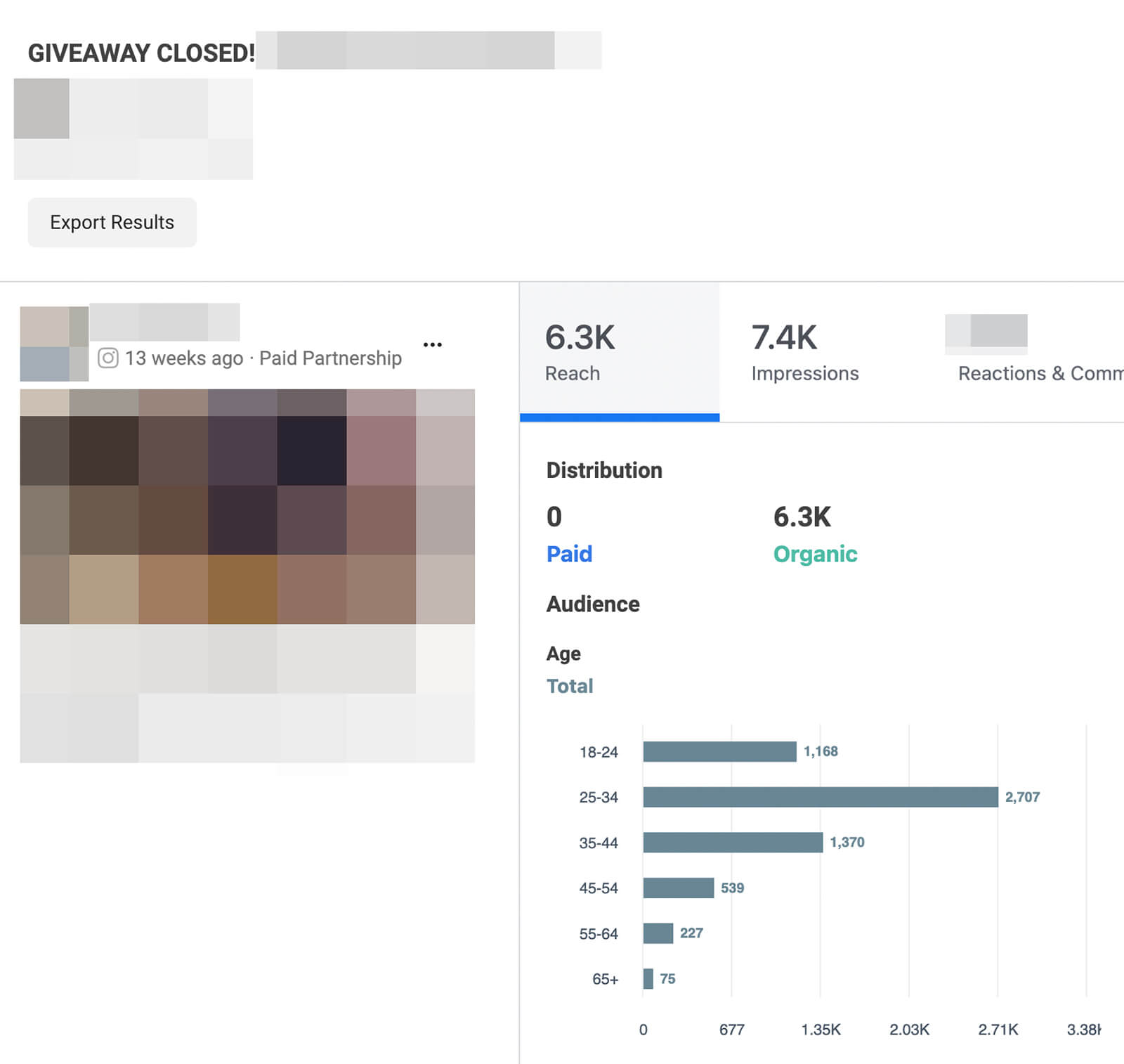
Creator Studio breaks down reach and impression metrics by age, gender, and location. It also reveals how many reactions, comments, and shares the content received. From here, you can click the Export Results button to share them with your team. Although you should have lifetime access to post, Reel, and Live metrics, Stories metrics disappear after 14 days.
Where to Find Micro-Influencer Analytics in Google Analytics
To monitor website traffic and eCommerce sales related to your influencer campaign, check Google Analytics. If your brand partners used a URL with a UTM code, you can track their traffic and sales numbers under the Campaigns section of the Acquisition tab.

If you provided brand partners with a unique URL, you can track them by clicking Direct from the Overview tab. You can use the search bar to search for specific influencer links or look for them in the Landing Page column. Whether your Google Analytics account tracks eCommerce or goals, it can reveal the conversions and revenue from each partnership.
Conclusion
Partnering with micro-influencers can be a helpful and cost-effective way to promote your brand, products, and services. With the workflows above, you can find the right micro-influencers for your brand, develop short- or long-term partnerships, and track results to better understand the value that these campaigns create.
Stay Up-to-Date: Get New Marketing Articles Delivered to You!
Don't miss out on upcoming social media marketing insights and strategies! Sign up to receive notifications when we publish new articles on Social Media Examiner. Our expertly crafted content will help you stay ahead of the curve and drive results for your business. Click the link below to sign up now and receive our annual report!
Attention Agency Owners, Brand Marketers, and Consultants

Introducing the Marketing Agency Show–our newest podcast designed to explore the struggles of agency marketers.
Join show host and agency owner, Brooke Sellas, as she interviews agency marketers and digs deep into their biggest challenges. Explore topics like navigating rough economic times, leveraging AI, service diversification, client acquisition, and much more.
Just pull up your favorite podcast app, search for Marketing Agency Show and start listening. Or click the button below for more information.

